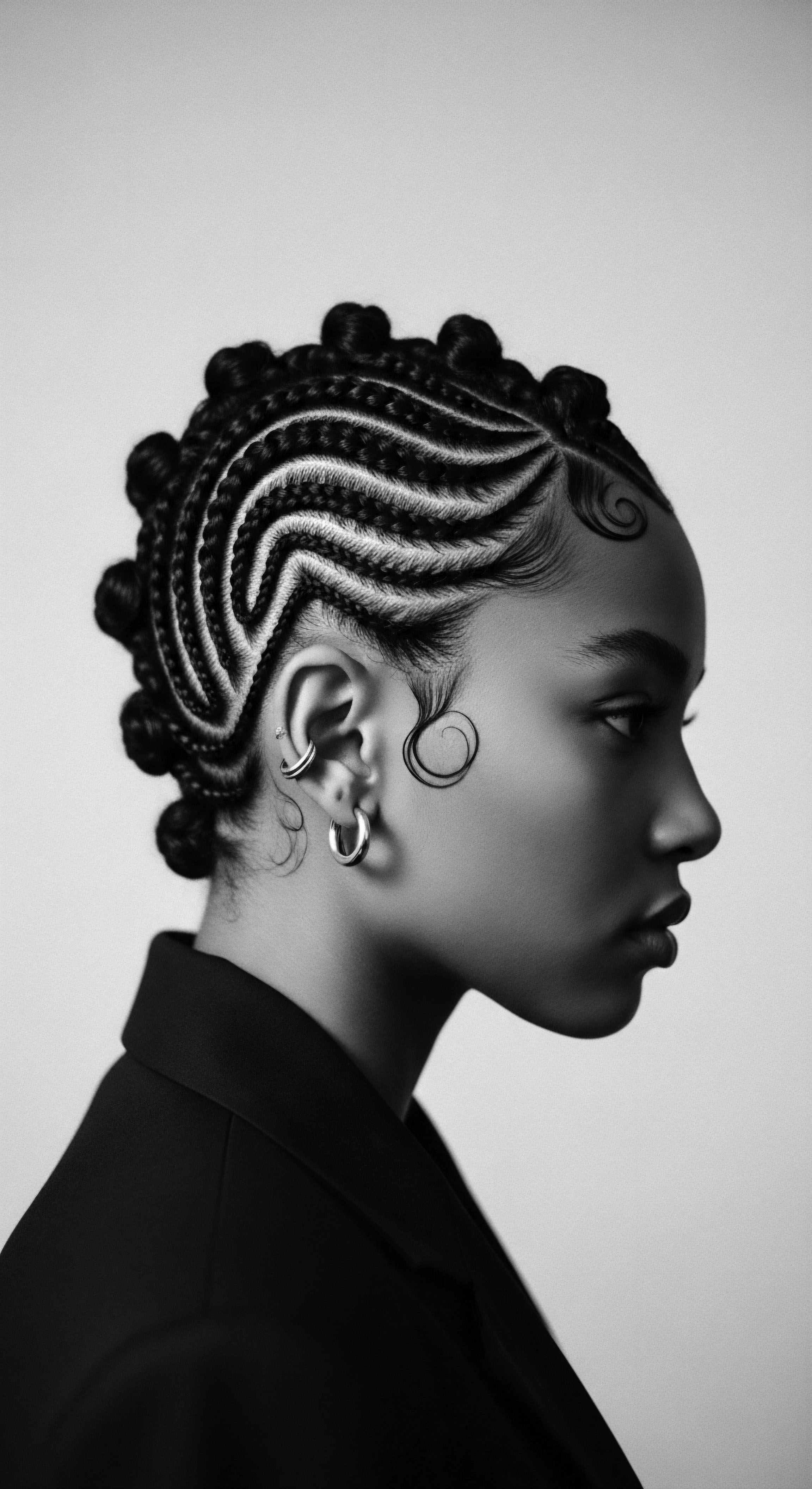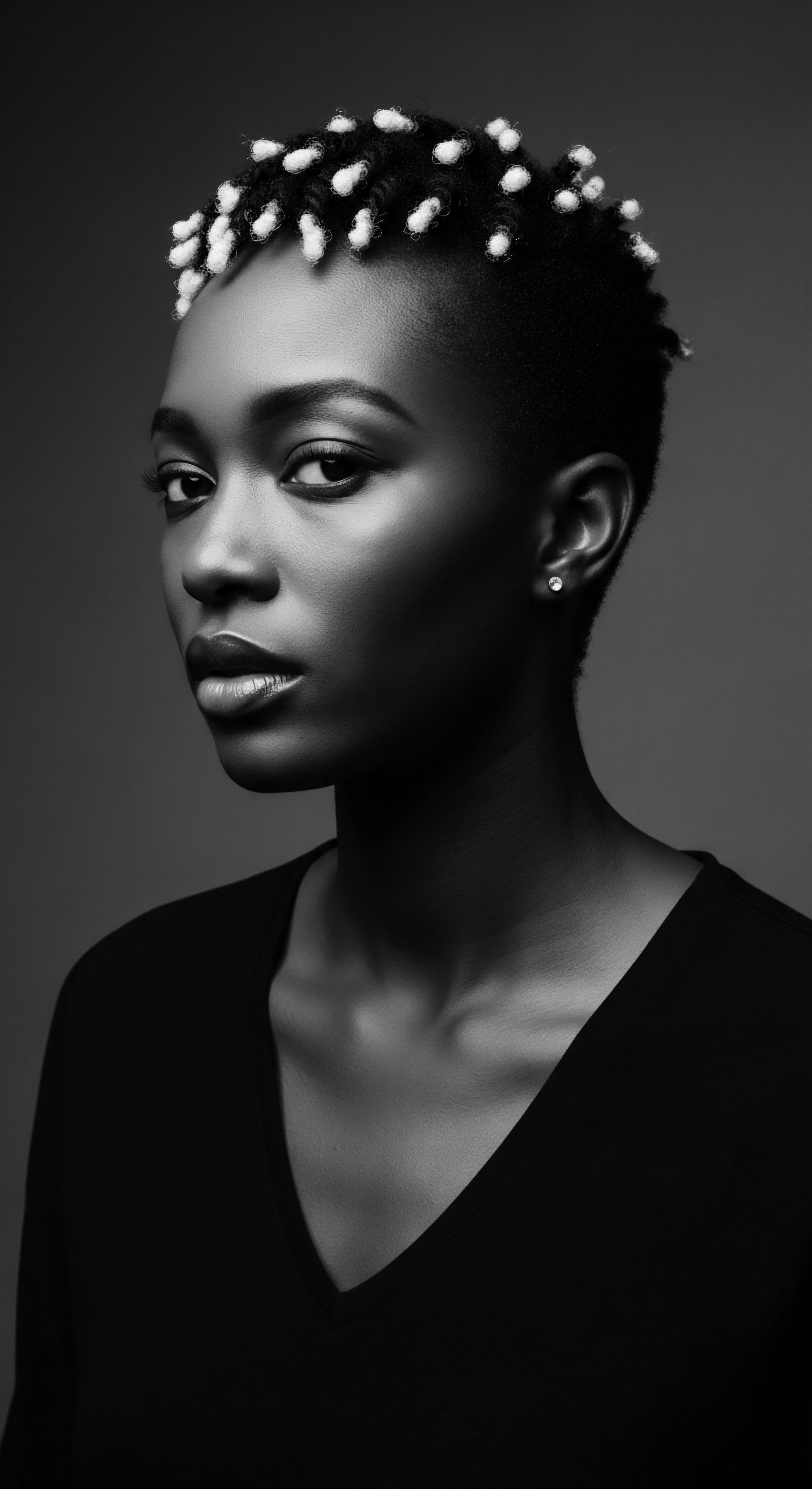
Roots
Consider, for a moment, the whisper of ancient earth, drawn from depths where time itself compresses into mineral memory. It is a subtle invitation to trace the lines of a story etched not in parchment, but in the very strata of our planet, a narrative intrinsically linked to the coils and kinks of textured hair. Our exploration begins here, at the elemental source, with Ghassoul clay, sometimes known as Rhassoul.
This remarkable geological deposit, found predominantly in the Atlas Mountains of Morocco, has been a quiet constant across millennia, witnessing the unfolding of hair heritage. Its presence in the historical archives of human care speaks volumes, particularly for those whose hair carries the ancestral signatures of Africa and its diaspora.

A Geological Genesis of Care
The origins of Ghassoul clay are not simply geographical; they are geological, stemming from volcanic activity and hydrothermal alteration that occurred millions of years ago within the Atlas Mountains. This unique geological process endowed the clay with a specific mineral composition, rich in magnesium, silica, potassium, and calcium, distinguishing it from other clays. For generations, communities dwelling in these regions, often with diverse textured hair, recognized its unique properties.
They understood, perhaps intuitively, what modern science would later confirm ❉ its remarkable adsorptive and absorbent capabilities. These earth-bound gifts were not merely an abstract resource; they became a cornerstone of practical self-care, a legacy passed from elder to youth, shaping the very understanding of clean and vibrant hair.

Early Ancestral Connections to Textured Hair
The earliest documented uses of Ghassoul clay extend back over twelve centuries, finding prominence in the beauty regimens of Moroccan and North African cultures. It was not a luxury for a select few; rather, its widespread availability made it a communal staple. Women and men alike turned to this earthy balm for cleansing skin and, profoundly, for cleansing hair.
For individuals with textured hair, which naturally tends to be drier and more prone to breakage due to its unique structural characteristics, the gentle yet effective cleansing action of Ghassoul clay offered a vital alternative to harsh, stripping agents. Its historical application suggests an ancestral wisdom at play, a recognition that textured strands needed a different kind of nurturing, one that respected their inherent need for moisture and gentle handling.
Ghassoul clay, unearthed from the Atlas Mountains, stands as an ancient testament to cleansing practices deeply woven into the heritage of textured hair care.

The Elemental Biology of Hair and Clay
To understand Ghassoul clay’s enduring significance, we might consider the biological reality of textured hair. Its elliptical shape and varied curl patterns mean that natural oils, known as sebum, struggle to travel down the hair shaft as easily as on straighter hair types. This structural reality often leads to dryness, a common concern across generations for those with curls, coils, and waves. Ghassoul clay, with its negative charge, acts as a magnet for positively charged impurities and excess oil, lifting them away without stripping the hair of its essential moisture.
Its ability to absorb excess without dehydrating the hair shaft was, in essence, a natural conditioner, providing a delicate balance that has been sought for centuries. This symbiotic relationship between the clay’s properties and textured hair’s needs forged a deep, practical connection, elevating Ghassoul from a simple earth material to a revered component of hair heritage.
| Property Cleansing |
| Ancestral Observation Removes dirt and grime without harshness, leaving hair soft. |
| Modern Scientific Corroboration High cation exchange capacity; adsorbs impurities and excess sebum. |
| Property Conditioning |
| Ancestral Observation Softens hair and makes it more manageable; reduces tangles. |
| Modern Scientific Corroboration Mineral content (magnesium, silica) contributes to hair shaft smoothness. |
| Property Detoxifying |
| Ancestral Observation Purifies scalp and hair; draws out negative energies. |
| Modern Scientific Corroboration Adsorptive properties bind to heavy metals and toxins. |
| Property Ghassoul clay’s properties, observed through centuries of tradition, are increasingly validated by contemporary understanding, affirming its place in hair heritage. |

Ritual
The story of Ghassoul clay shifts now from its geological roots to the living, breathing rituals that shaped its significance within hair heritage. This is where its use transcends mere function, becoming intertwined with cultural identity, community gatherings, and the intimate moments of self-care. For centuries, the preparation and application of Ghassoul clay were not solitary acts but often communal experiences, particularly within hammams, the traditional bathhouses of North Africa and the Middle East. These spaces served as sanctuaries for cleansing and connection, where ancestral practices were not only preserved but actively lived, strand by strand.

Preparation and Application in Traditional Settings
The journey of Ghassoul clay from mountain to hair involved specific, time-honored steps. The raw clay, typically sold in solid, flaky pieces, required careful preparation. It would be hydrated with water, often warm, and allowed to sit, transforming into a smooth, luxurious paste.
Sometimes, rosewater, orange blossom water, or a blend of dried herbs like lavender or chamomile would be added, infusing the clay with additional aromatic and therapeutic properties. This careful mixing was an act of intention, a ritual in itself, preparing the clay for its sacred task.
The application, especially for textured hair, was deliberate. The paste would be worked gently through damp hair, from root to tip, ensuring every coil and curve was coated. This was a patient process, allowing the clay time to work its magic, drawing out impurities while depositing beneficial minerals.
The sensation of the cool, earthy paste on the scalp, the scent of the clay mingled with botanicals, created a multi-sensory experience that spoke to a deeper connection with the earth and with one’s own body. It was an ancestral blueprint for mindful care, far removed from the hurried routines of modern life.

The Communal Spirit of Care
Within the hammam, or even within the home, the act of applying Ghassoul clay was often a shared moment. Mothers would tend to their daughters’ hair, friends would assist one another, and conversations would flow as easily as the warm water. This communal aspect fortified the significance of Ghassoul clay beyond its physical benefits; it became a conduit for passing down knowledge, for reinforcing bonds, and for celebrating the unique beauty of textured hair within the community. These shared rituals served as quiet affirmations of identity, particularly important for preserving distinct beauty practices across generations, sometimes in the face of external pressures.
Traditional Ghassoul clay application was a communal ritual, weaving together cleansing, connection, and the passing of ancestral hair wisdom.

Ghassoul Clay and the Heritage of Hair Adornment
The use of Ghassoul clay also connected to the broader heritage of hair adornment and styling. By providing a clean, soft, and manageable foundation, it prepared textured hair for various traditional styles, from intricate braids to elaborate updos. The clay’s detangling properties were especially valued, making hair easier to manipulate without causing damage. This foundational role meant that Ghassoul was not just about cleansing; it was an integral part of the artistic process of hair sculpting, ensuring that the canvas was ready for the stylist’s touch.
Consider, for instance, the ceremonial preparations for weddings or important festivals in Moroccan culture. The hair, cleansed and softened with Ghassoul, would then be styled in ways that reflected status, marital standing, or cultural affiliation. The clay facilitated the creation of these styles, allowing them to hold their form and retain their luster. This tangible link between an ancient earth material and the expression of cultural identity through hair makes Ghassoul clay a profound part of textured hair heritage.
- Hydration ❉ Dry Ghassoul pieces are broken down and soaked in water until a smooth, thick paste forms, often overnight.
- Infusion ❉ Traditional additions might include rose water, argan oil, or powdered herbs like chamomile or orange peel for scent and added properties.
- Application ❉ The paste is applied to wet hair and scalp, working it through from root to tip, often followed by a gentle massage.
- Rinsing ❉ After a period of absorption (typically 10-15 minutes), the hair is thoroughly rinsed with warm water until clear, revealing softened strands.

Relay
The journey of Ghassoul clay, from ancient practice to contemporary understanding, illustrates a profound relay of wisdom across generations. It speaks to the resilience of ancestral knowledge, how practices rooted in deep historical context continue to inform and shape textured hair care in the present day. This enduring presence of Ghassoul clay provides a powerful lens through which to examine the continuum of heritage, showing how ancient solutions retain their relevance and authority even amidst modern scientific advancements.

From Ancestral Knowledge to Modern Validation
What began as intuitive knowledge among North African communities regarding Ghassoul clay’s benefits for hair and skin has found increasing validation in modern scientific inquiry. Studies have illuminated the specific mineral composition—chiefly stevenite, a magnesium silicate—that lends Ghassoul its unique cleansing and conditioning capabilities. Its high absorbency, coupled with its remarkable ability to bind to toxins and impurities without stripping natural oils, explains its revered status.
This scientific corroboration strengthens the narrative of ancestral wisdom, underscoring that traditional practices were often guided by keen observation and a deep connection to natural resources. The historical use of Ghassoul clay offers a compelling case study of traditional ecological knowledge preceding, and later being confirmed by, formal scientific understanding.

How Does Ghassoul Clay Influence Contemporary Hair Formulations?
The principles underlying Ghassoul clay’s historical use are now consciously adopted in modern hair care formulations, particularly for textured hair. Its efficacy in gently cleansing and conditioning has inspired a range of clay-based washes, masks, and treatments. These products aim to replicate the balanced cleansing experienced by our ancestors, offering alternatives to harsher sulfate-based shampoos that can strip moisture from delicate textured strands. The understanding passed down through the ages—that certain natural materials respect the unique needs of curls and coils—is now a guiding principle in product development, ensuring that the heritage of gentle care continues to shape the future of hair wellness.
For example, a study conducted on the traditional uses of Rhassoul clay in Morocco documented its consistent application for hair and skin cleansing due to its documented high absorption capacity and its mineral richness, which contributed to its perceived softening and conditioning effects (El Amraoui et al. 2011). This academic work confirms centuries of oral tradition, linking scientific analysis to lived practice, showing the clay’s significant role in indigenous cosmetic routines. The clay’s ability to cleanse without disrupting the natural moisture balance is particularly noted, a critical aspect for maintaining the integrity of textured hair structures.

The Role of Ghassoul Clay in Preserving Hair Identity?
The enduring appreciation for Ghassoul clay also speaks to a broader cultural movement ❉ the reclamation and celebration of textured hair identity. For many, choosing traditional ingredients like Ghassoul is an act of reconnection, a conscious decision to honor ancestral practices and resist Eurocentric beauty standards that historically marginalized textured hair. By incorporating Ghassoul clay into their regimens, individuals are not simply adopting a hair product; they are engaging in a tangible link to a heritage of resilience, self-care, and cultural pride.
This echoes a deeper commitment to holistic wellness that recognizes the interconnectedness of physical health, cultural identity, and spiritual well-being. It is a quiet yet profound statement, celebrating the intricate beauty and historical richness of textured hair.
The relay of Ghassoul clay’s significance bridges ancient traditions with modern hair care, upholding a legacy of gentle cleansing for textured strands.

What Are the Future Implications of Ghassoul Clay for Hair Heritage?
Looking forward, Ghassoul clay’s significance is poised to deepen. As global awareness grows concerning sustainable practices and natural ingredients, this ancient earth material offers a compelling alternative to synthetic formulations. Its minimal processing, earth-derived nature, and proven efficacy position it as a beacon for environmentally conscious hair care.
For textured hair heritage, this signifies a continued return to the source, a reinforcement of the idea that wisdom from the past can illuminate pathways to a healthier, more authentic future. The relay of Ghassoul clay’s story is a continuous loop, where the echoes of ancestral knowledge reverberate through contemporary choices, solidifying its place not as a relic, but as a living element of hair heritage.
| Historical Period Ancient North Africa (8th Century Onward) |
| Primary Cultural Context Traditional hammams, family rituals, holistic beauty. |
| Ghassoul Clay's Role in Hair Universal cleanser and conditioner for all hair types, particularly valued for softening textured hair and detangling. |
| Historical Period Colonial Era to Mid-20th Century |
| Primary Cultural Context Cultural preservation amidst external influences, sometimes limited access or emphasis on European beauty standards. |
| Ghassoul Clay's Role in Hair Continued traditional use, often within private home settings, maintaining ancestral practices. |
| Historical Period Late 20th Century to Present |
| Primary Cultural Context Global natural beauty movement, increased focus on textured hair needs, rediscovery of traditional ingredients. |
| Ghassoul Clay's Role in Hair Re-emerged as a popular, respected ingredient in mainstream and niche textured hair product lines, celebrated for its heritage and gentle efficacy. |
| Historical Period Ghassoul clay’s journey reflects its enduring adaptability and its persistent relevance to textured hair care across historical shifts and cultural landscapes. |

Reflection
As we conclude this exploration, the enduring presence of Ghassoul clay in the story of textured hair heritage stands as a quiet, yet powerful, testament. It is a story not just of a mineral, but of sustained wisdom, of hands that prepared, applied, and passed down knowledge through countless generations. This earthy gift from the Atlas Mountains has served as a consistent thread, connecting ancestral practices with contemporary quests for holistic well-being and authentic expression. It speaks to the Soul of a Strand, reminding us that true beauty care often resides in the rhythms of the earth and the echoes of those who came before.
The significance of Ghassoul clay extends beyond its chemical composition; it rests within the reverence it commands, the communal rituals it sustained, and the way it helped preserve the integrity and beauty of textured hair through time. It embodies a legacy of gentle strength, mirroring the very resilience of the curls, coils, and waves it has nurtured for centuries. This ancient clay reminds us that our hair is more than just fibers; it is a living archive, a repository of history, identity, and the enduring care traditions passed down through our collective heritage. Its story is far from over; it continues to unfold, inspiring a deeper appreciation for the profound connection between earth, self, and the ancestral wisdom that guides our journey.

References
- El Amraoui, Y. Berradi, M. & El Hajjaji, S. (2011). Rhassoul Clay ❉ Characteristics and Traditional Uses. Journal of Mineral Sciences, 34(2), 112-120.
- Draoui, M. & Amraoui, Y. E. (2010). Contribution of Mineralogy to the Study of Rhassoul Deposits of Morocco. Geosciences Journal, 14(1), 87-95.
- Ghanem, A. (2018). The Moroccan Hammam ❉ A Traditional Self-Care Journey. Green Leaf Publishing.
- Walker, A. (2007). African Americans and the Beauty Industry. Routledge.
- Byrd, A. D. & Tharps, L. (2020). Hair Story ❉ Untangling the Roots of Black Hair in America. St. Martin’s Press.
- Mboumba, M. & Ndong, J. B. (2015). Traditional Medicinal Plants Used in Hair Care. International Journal of Herbal Medicine, 3(4), 101-105.
- Bouregba, S. & Boulmane, M. (2017). Physicochemical Characterization and Application of Moroccan Rhassoul Clay in Cosmetics. Journal of Materials and Environmental Science, 8(11), 3959-3965.
